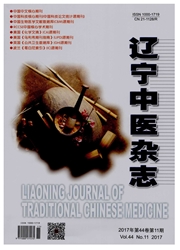

 中文摘要:
中文摘要:
目的:探讨萎胃康颗粒逆转慢性萎缩性胃炎(CAG)的机制。方法:将90只SD大鼠随机抽取18只为正常对照组(正常组),其余72只采用多重刺激6周复制大鼠CAG模型。确定造模成功的64只随机分为4组,即模型对照组、萎胃康大剂量组、萎胃康小剂量组、三九胃泰组,分别ig生理盐水、萎胃康高浓度水煎液、萎胃康低浓度水煎液和三九胃泰混悬液,1次/d。给药30d后,观察对大鼠胃黏膜组织形态及突变型p53表达的影响。结果:模型组大鼠胃黏膜病理无明显改善,突变型p53表达较正常组显著升高(P〈0.01);各治疗药物均可显著改善胃黏膜萎缩,降低胃黏膜突变型p53表达,较模型组具有显著性差异(P〈0.01)。其中以萎胃康大剂量组大鼠胃黏膜p53的平均光密度最低,较其他治疗组有显著性差异(P〈0.01)。结论:萎胃康能改善和逆转实验性萎缩性胃炎大鼠胃黏膜萎缩,其疗效与剂量有关,其机制可能与抑制细胞的异常增殖有关。
 英文摘要:
英文摘要:
Objective : To discuss the mechanism of Weiweikang reversing chronic atrophic gastritis. Methods : 18 rats from 70 SD rats were randomly selected out as normal control group (normal group). The remaining 72 rats were made CAG model with the multiple stimulations for 6 weeks. The remaining 64 rats which were modeled successfully were randomly divided into four groups such as model group, Weiweikang large dose group, Weiweikang small dose group and Sanjiu Weitai group. The groups were injected 0.9% saline,Weiweikang high potency decoction,Weiweikang low potency decoction and Sanjiu Weitai suspension, once a day. After 30 days, the gastric mucosa pathological changes and the expression of mutant p53 were observed. Results:There was no significant differentiation of gastric mucosa pathematology in model group. The expression of mutant p53 made a significant increase compared with model group ( P 〈 0.01 ). The therapeutic drugs all could significantly improve gastric mucosa atrophy and reduce the expression of the mutant p53 and compared with the model group there was obvious difference( P 〈 0.01 ). The average optical density of mutant io53 in Weiweikang large dose group was minimum, with significant difference compared to the other ther- apeutic groups (P 〈 0.01 ). Conclusion:Weiweikang can improve and reverse the gastric atrophy of experimental atrophic gastritis of rats, which related to dose. Its mechanism may be related with restraining cell proliferation.
 同期刊论文项目
同期刊论文项目
 同项目期刊论文
同项目期刊论文
 期刊信息
期刊信息
